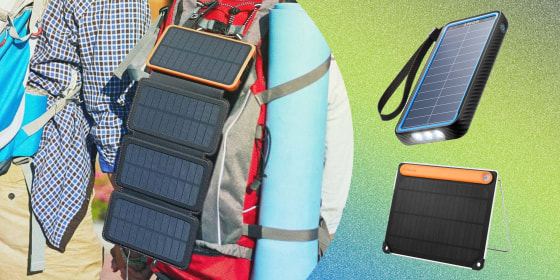
4 highly rated solar power banks to shop this year
Experts share the benefits solar power banks offer and how they work. We also rounded up highly rated models.




Capacity: 12W, 10,000mAh
Compatibility: 2 USB-A ports
In addition to sunlight captured through the built-in solar cells, the brand said you can also charge this solar power bank’s battery via a 10.5W wall charger. The PowerCore Solar 10000 is designed with an integrated flashlight with three modes: low brightness, full brightness and SOS mode. Anker said the device has a solar efficiency rating of between 21.5 percent and 23.5 percent and is IP64-rated, meaning it's dust and water splash resistant.
Capacity: 25,000mAh
Compatibility: 2 USB-A ports
Gordon previously recommended this Hiluckey solar power bank in our guide to solar-powered gadgets. It features solar panels that fold out when you want to use them, and you can also recharge the battery by plugging it into an outlet. The solar power bank features a built-in flashlight with three modes: normal, SOS and strobe.
Capacity:8,000 mAh
Compatibility: 2 USB-A ports
In addition to relying on the sun, the battery built into this solar power bank from 4PATRIOTS can be charged using an outlet. The brand said it has an IP67 rating, meaning it’s resistant to rain and splashes. The solar power bank is designed with a LED flashlight with an SOS mode, as well as a battery indicator — when all of the power bank’s four blue lights are lit, it’s fully charged.
While shopping for a solar power bank, experts told us it’s important to think about what’s best for your needs and the devices you own. Keep price point in mind, too — based on our research, we noticed that devices with more or larger solar panels, as well as higher power capacities, often cost more. Some solar power banks feature built-in flashlights, too, which may come in handy during emergency situations like blackouts. Here’s what experts recommend you consider before buying.
Every device is designed with a different size battery, which can help guide your shopping. According to our previous reporting, when it comes to power banks, charging capacity is often measured in milliamp-hours (mAh) or watt-hours (Wh) — all solar power banks we recommend listed capacity in mAh, but only some included capacity in watts.
Watt-hours (Wh) is one way to measure charging capacity and will give you the best estimate of how much or how many times the charger can charge your device.
Milliamp-hours (mAh) can be useful when comparing the capacities of different battery packs. For example, a 5,000mAh battery pack will provide fewer charges than a 12,000mAh model.
Generally, devices that are physically larger in size with higher energy demands have larger batteries, and thus require higher capacity chargers to expedite charging, Mazumder said. And if listed, experts told us to compare a solar power bank’s wattage to your device’s charger when shopping.
“If it says ‘works best with a charger that’s rated at 27W and higher,’ then go look for the 27W-and-higher charger,” said Brad Saunders, chairman of the nonprofit USB-IF, in our guide to portable chargers. However, Mazumder said lower capacity chargers may still power larger devices, just at a slower rate than higher capacity options.
As a rule of thumb, Gordon explained, “a typical phone can charge at 5W, but most modern phones contain fast charging capabilities up to 18W. And if you’re charging two devices at once, you’ll need enough wattage for both.” Gordon also suggested checking a solar panel’s efficiency rating when shopping — however, efficiency ratings are not always listed. He said the higher the percentage, the more solar energy you can convert into charging power, and noted that anything above 20-percent efficiency is ideal.
Before you purchase a solar power bank, Mazumder said to make sure its ports are compatible with your electronics. Many solar power banks are built with USB-A ports, while some may come with an additional USB-C port.
Mazumder said people often buy new models of electronic devices and do so at a faster rate compared to buying solar power banks and other charging accessories. Thus, the type of port on your new phone might not match the port on your two-year-old solar power bank, causing you to have to purchase adapters to continue to use it in the future.
According to Mazumder, the number and size of solar cells on solar power banks impact how much power they can generate.
When there are more solar cells on a charger — or larger cells — they can generate more power. Gordon noted that some solar battery banks only have one panel, limiting the amount of power they can generate. But more and larger solar cells may mean that the physical size of the solar power bank increases — you may need to decide if you want to prioritize size or power while shopping.
Catch up on Select's in-depth coverage of personal finance, tech and tools, wellness and more, and follow us on Facebook, Instagram and Twitter to stay up to date.